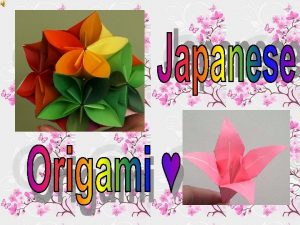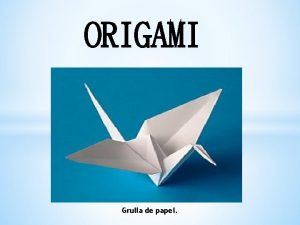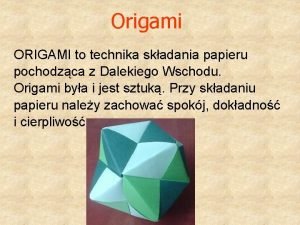Natures Origami What is origami Japanese art of

















- Slides: 17

Nature’s Origami

What is origami? Japanese art of folding paper into decorative shapes and figures. 2

Why Origami? Arises from powerful mathematical principles that work just as well in the world of metal and plastic as in paper. With origami, it’s possible to create large structures that fold up for transportation or for squeezing into tiny spaces. The intricate folding patterns can be used to make complex mechanical systems with movements that can be controlled by a single motor. 3

EXAMPLES Deep-Sea Grabber Harvard University roboticist Robert Wood recently used origami to design a grabber for catching delicate deepsea creatures. The device’s five arms feature interconnected pentagons and triangles that fold to form a 12 -sided container used to trap soft-bodied marine animals like jellyfish and octopuses without harming them 4

EXAMPLES Bullet-proof shield Conventional bulletproof shields used by police can weigh 90 pounds or more and provide protection for one person only. But a team of engineers at Brigham Young University used origami to design a 55 -pound shield that is wide enough to protect several people and yet can be folded into a shape that fits easily into the trunk of a car. 5

EXAMPLES Tiny Ingestible Robots 6 What if you could swallow a robot that could move about inside your body to perform simple surgical procedures? Such a scenario might be closer to reality than you might imagine, now that researchers at MIT have created an origamiinspired bot that folds small enough to fit in a pill; once inside the body, it’s designed to unfurl and steer its way through the gut with help from external magnet

EXAMPLES Star Shade Engineers at the Jet Propulsion Lab are developing a giant flowershaped shade designed for use with space telescopes. The shade would fold up during launch and then unfurl in space before being positioned in front of an orbiting space telescope to block starlight and permit detailed observations of exoplanets. 7

Simple Fly 1. Start with a square sheet of paper and cut it in half along the diagonal to get an isosceles triangle. 2. Fold in half and unfold. 3. Fold up the two bottom corners so the corners meet at the peak of the triangle. 8

Simple Fly 4. Fold the two corners back down, except fold them at a bit of an angle so the corners are slightly away from one another like the wings of a bug. 5. Fold down the top of the triangle; don't fold down exactly in half, leave a small gap as shown. Unfold 9

Simple Fly 6. Fold down the top section of the triangle into thirds. Then fold down once more along the crease made above. 7, Fold back the left & right sides of the model to form the body of the fly. 8. Fold the tips of the wings a little so it is not so pointy 10

Lotus 1. Start with a square sheet of paper 2. Make a triangular fold from bottom left to top right. Crease and unfold. 3. Make a triangular fold from bottom right to top left. Crease and unfold. 11

Lotus 4. Start with bottom right corner. Fold into center and crease. 5. Fold bottom left into center. Crease 6. Repeat with the remaining two corners. 12

Lotus 7. Fold top right corner into center. 8. Repeat with other corners. 9. Flip over 10. Repeat steps 7 and 8 again. 13

Lotus 11. Fold top flap along dotted line. 12. Repeat with other flaps. 13. Flip over 14

Lotus 14. Fold outer flap along dotted line. 15. Repeat on other 3 side. 16. Fold last flap up on dotted line. 15

Lotus 16

Extra Credit ⊷ Go to the link online and make any of the other insects and bring to school and show me 17
 Origami spiny lobster
Origami spiny lobster Nature and scope of learning
Nature and scope of learning Nothing gold can stay theme
Nothing gold can stay theme Nothing gold can stay analysis answer key
Nothing gold can stay analysis answer key Natures pure purifier
Natures pure purifier Natures%20truth%20men
Natures%20truth%20men Art and culture in heian
Art and culture in heian Christian origami
Christian origami Rigid origami simulator
Rigid origami simulator Alat alat kolase
Alat alat kolase Costruiamoli
Costruiamoli Origami risk login
Origami risk login Centro diffusione origami
Centro diffusione origami Origami faltkunst
Origami faltkunst Paper toc
Paper toc Origami james webb
Origami james webb Origami tulipan
Origami tulipan Origami risk
Origami risk































